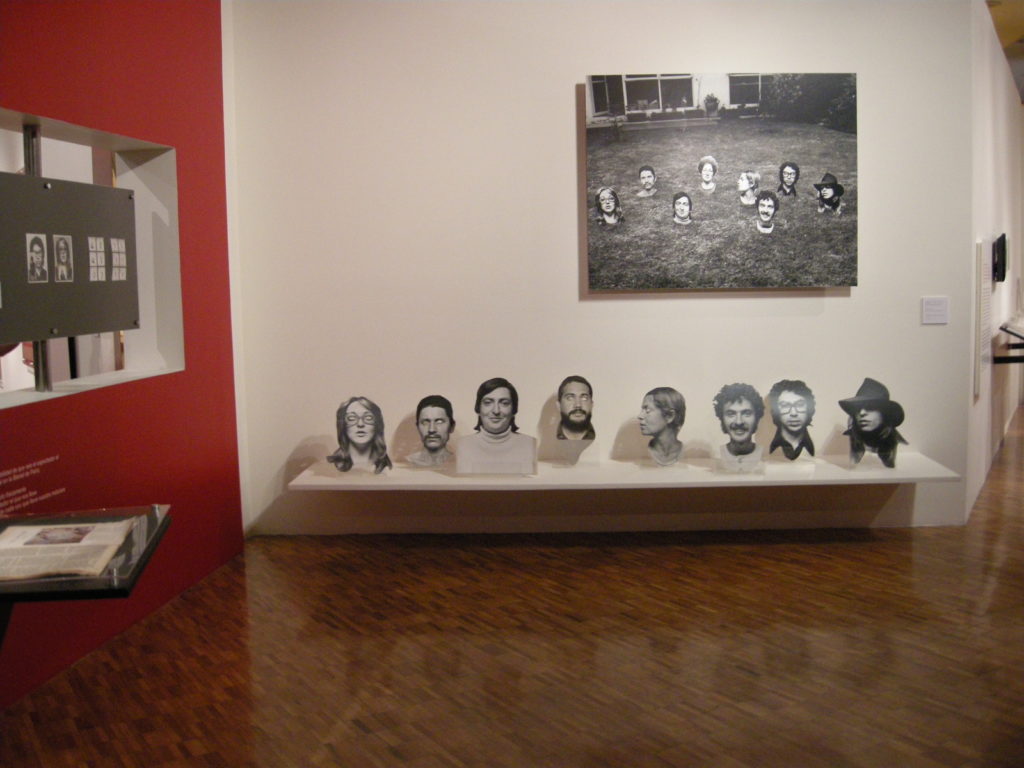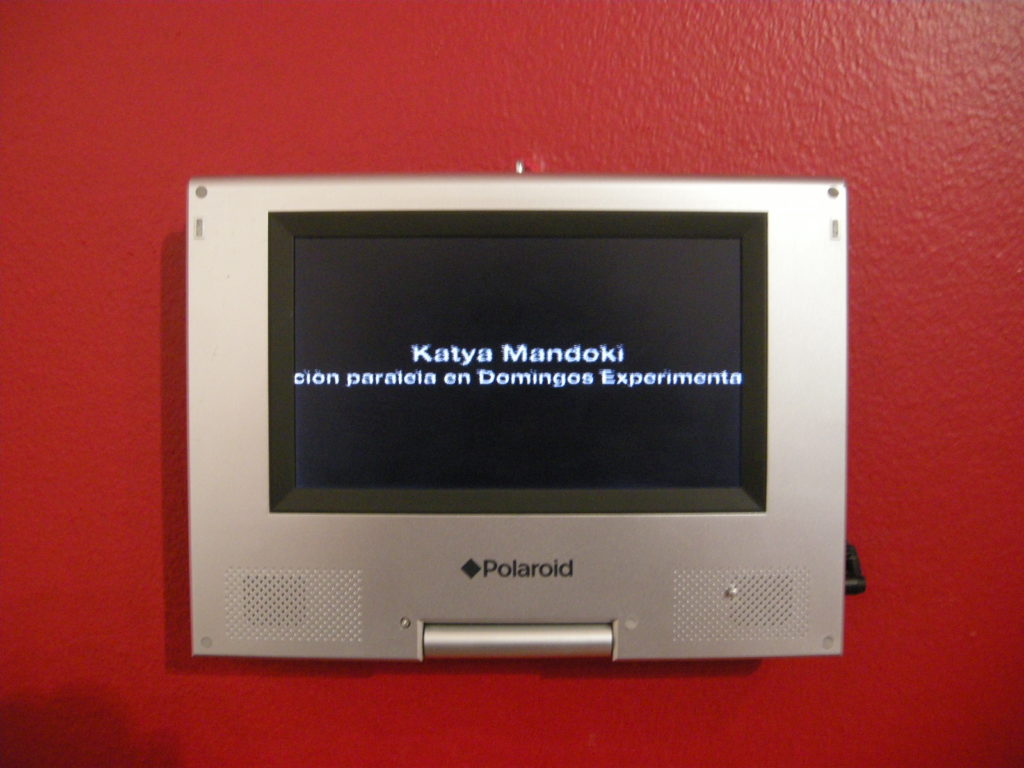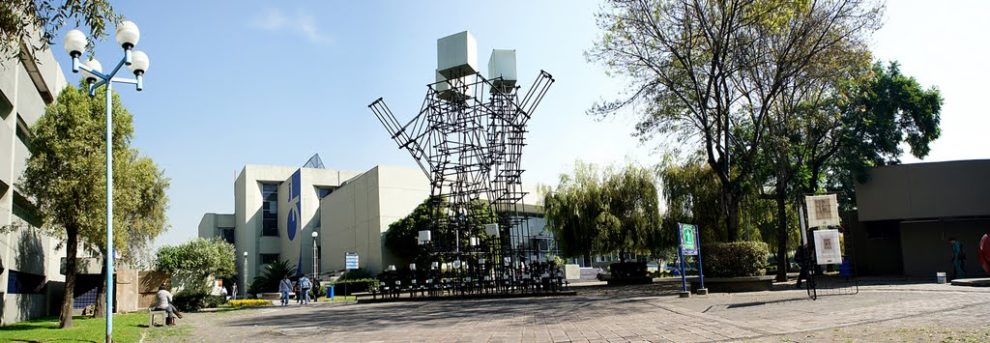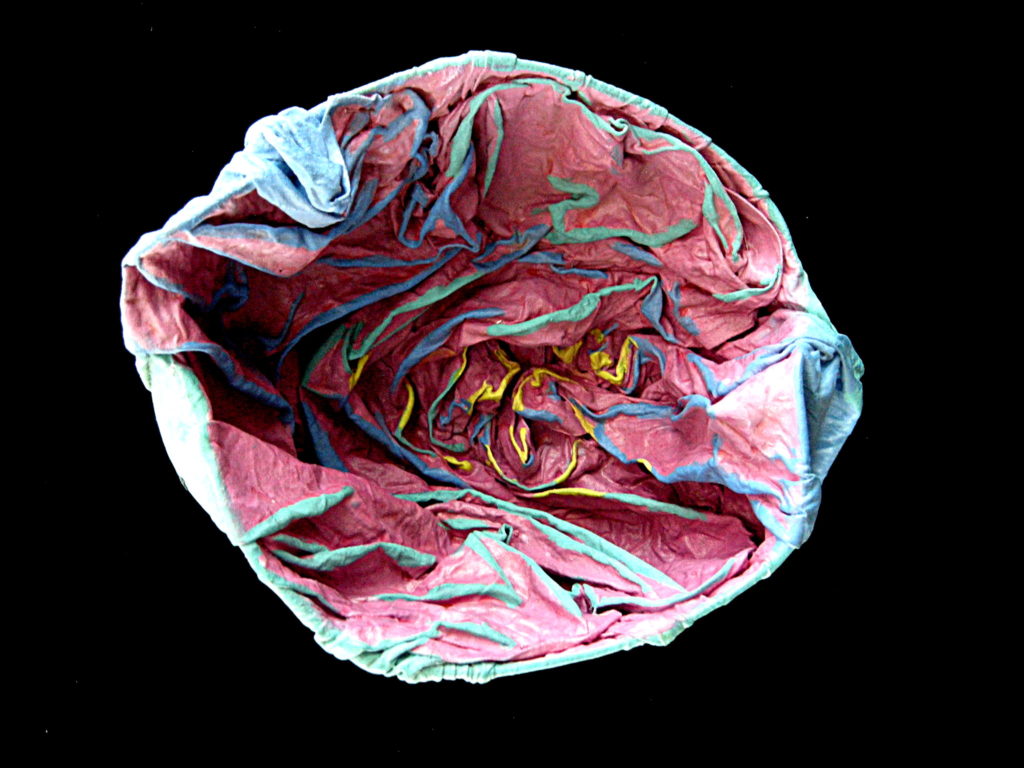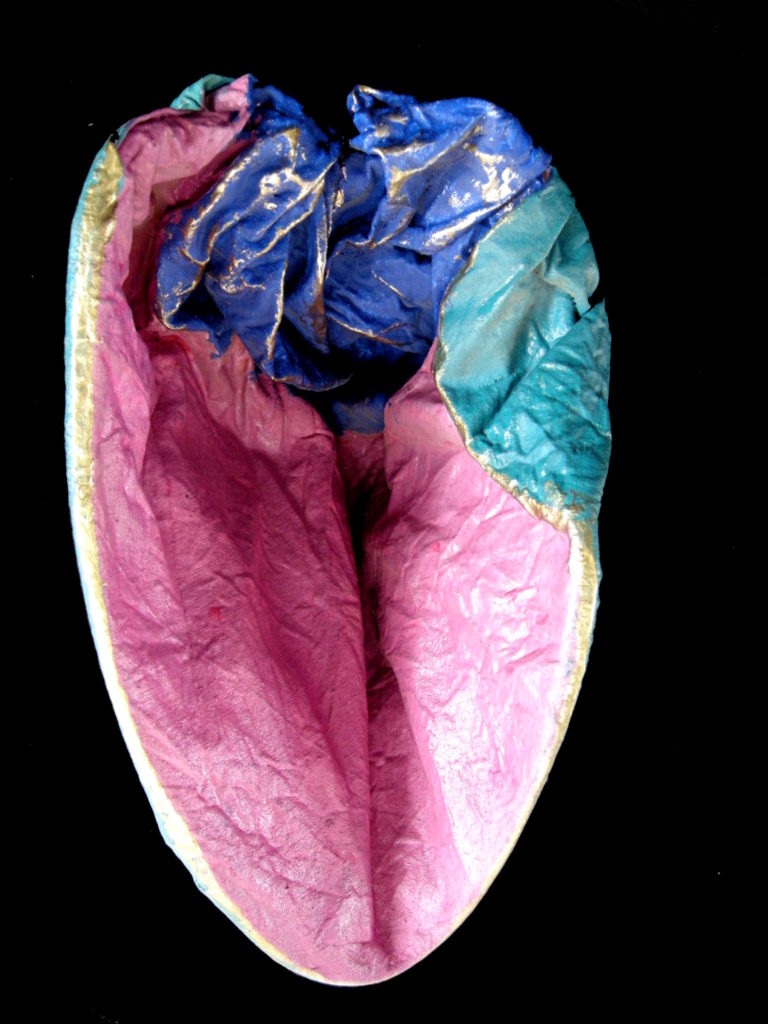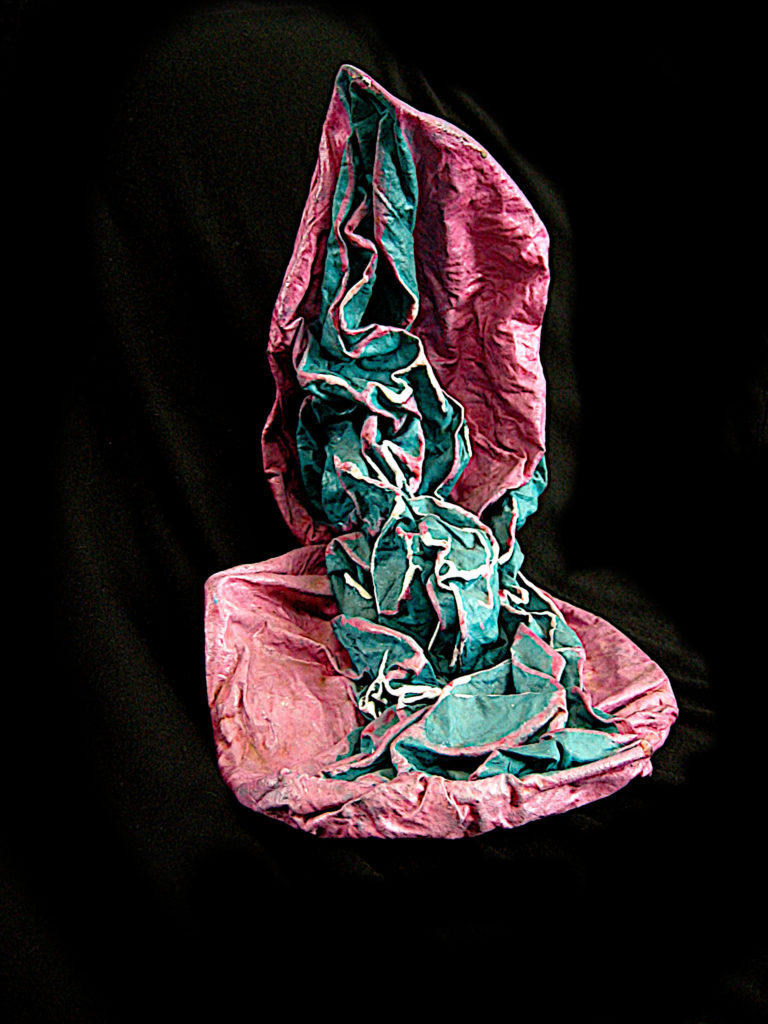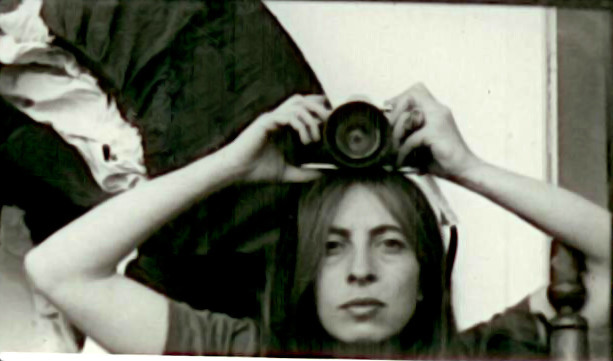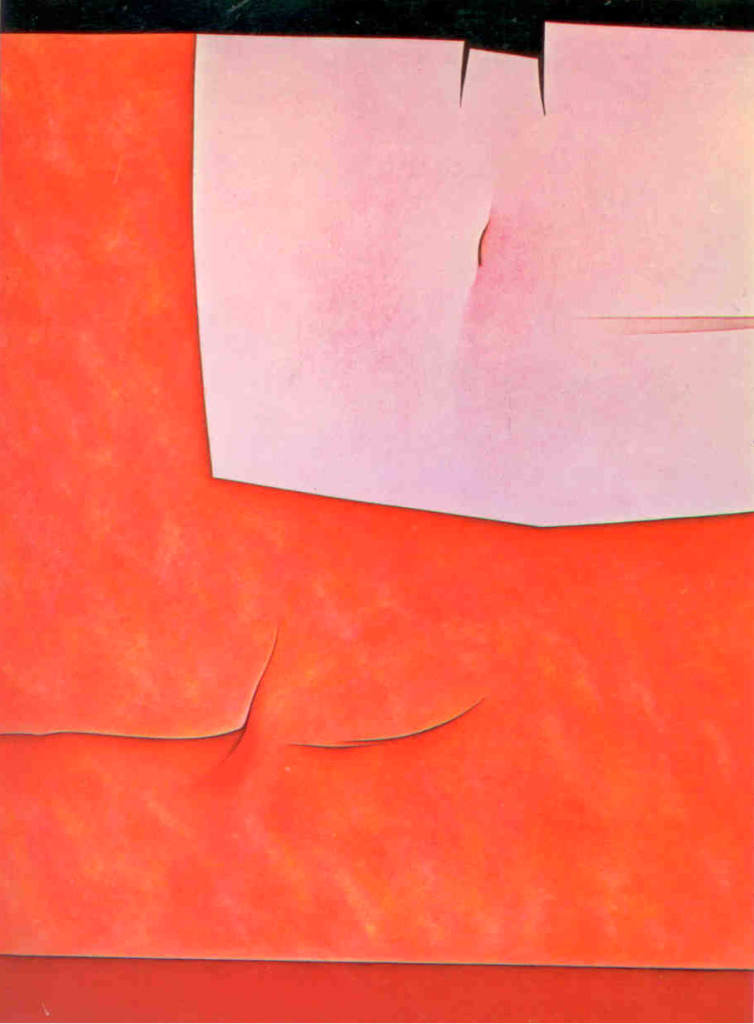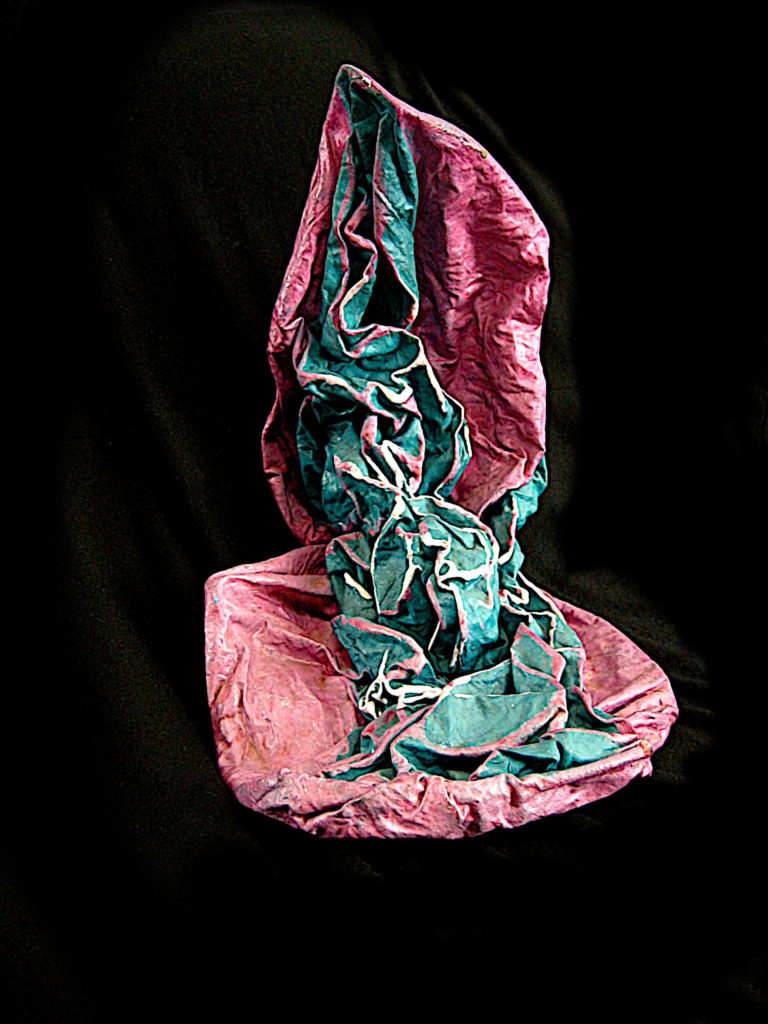Concavexities (sculpaintings 1975-1978)
This is an exploration inspired by Lucio Fontana’s later pierced canvas series, of real space paintings evolving from the plane to three-dimensionality and discovering the formal and textural possibilities of the material itself. Acrilic on wrinkled prepared canvas.
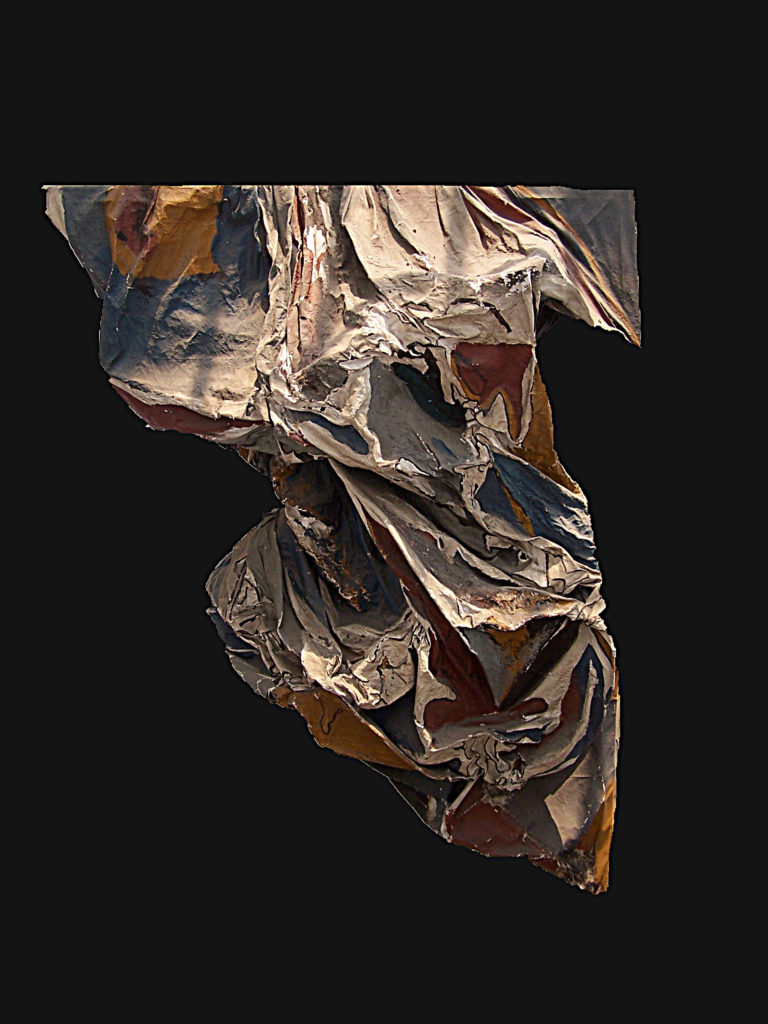
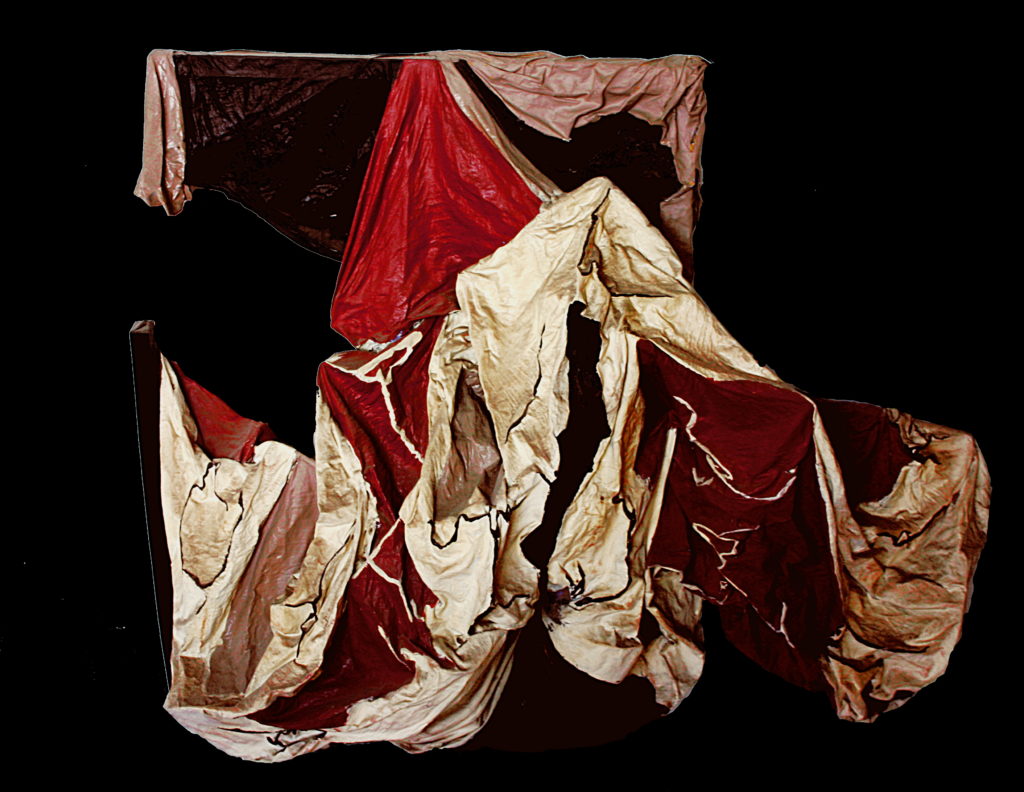
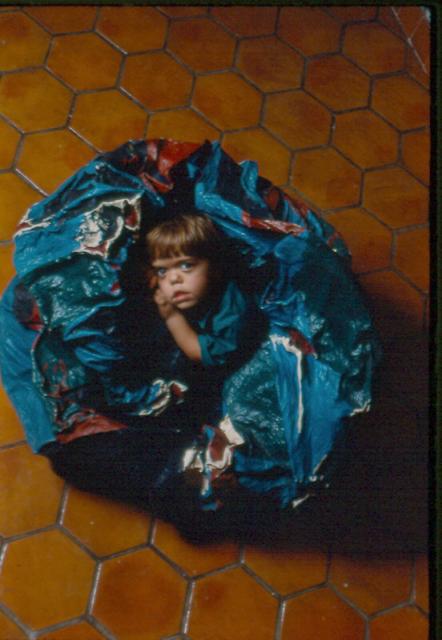
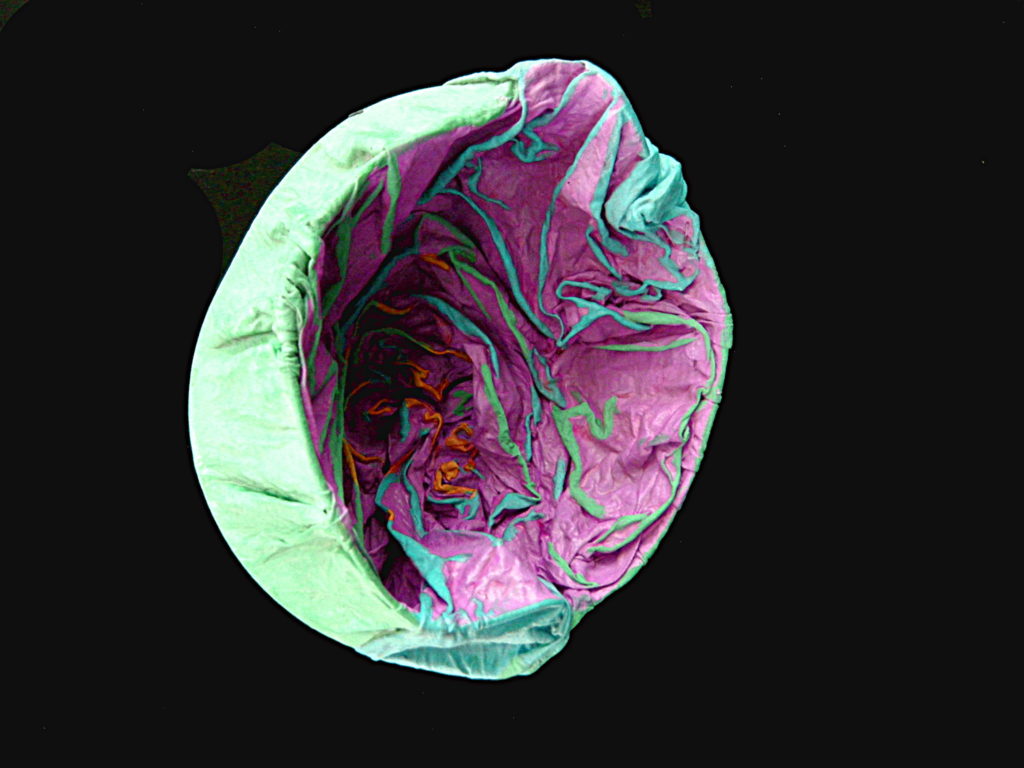
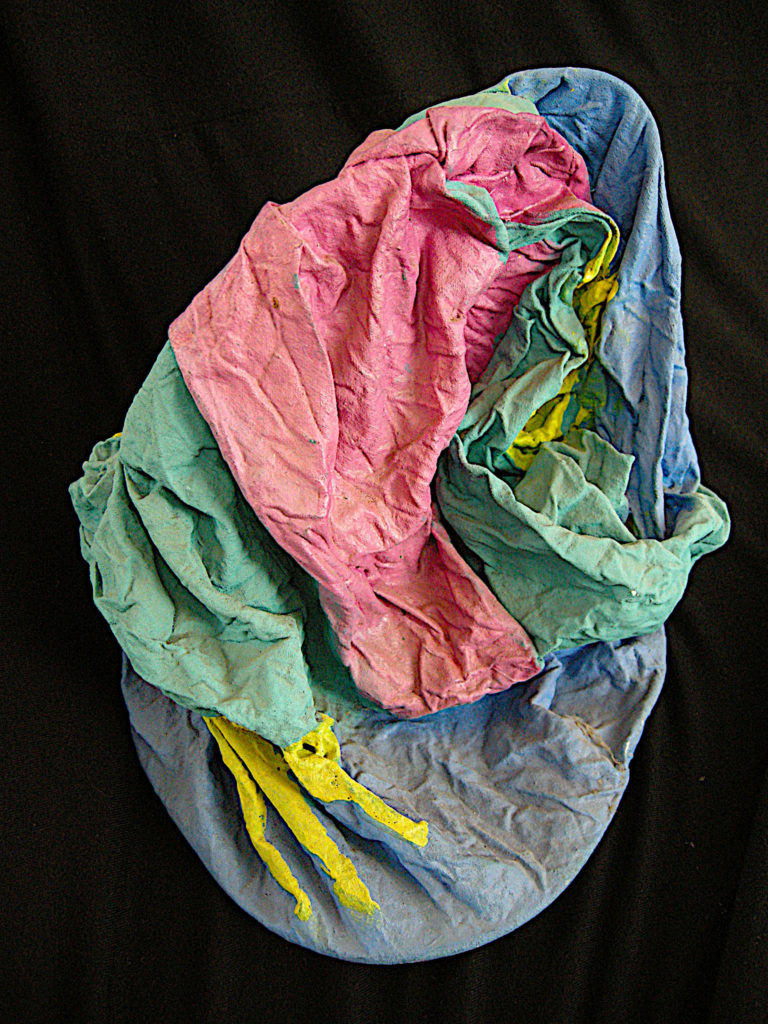
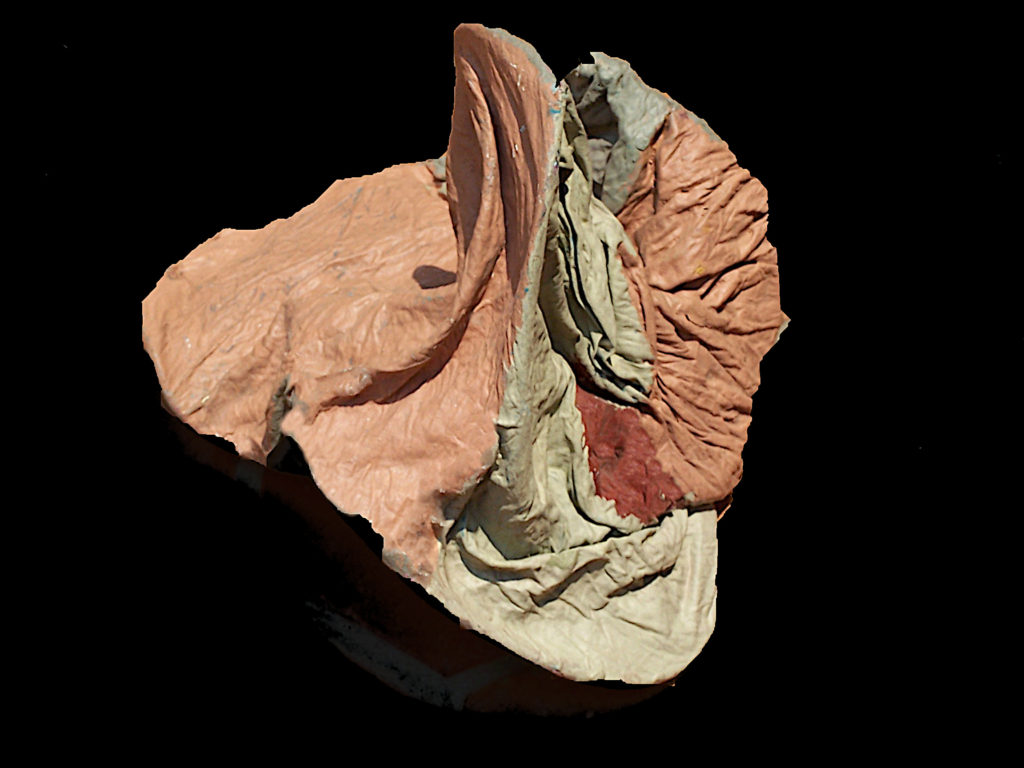

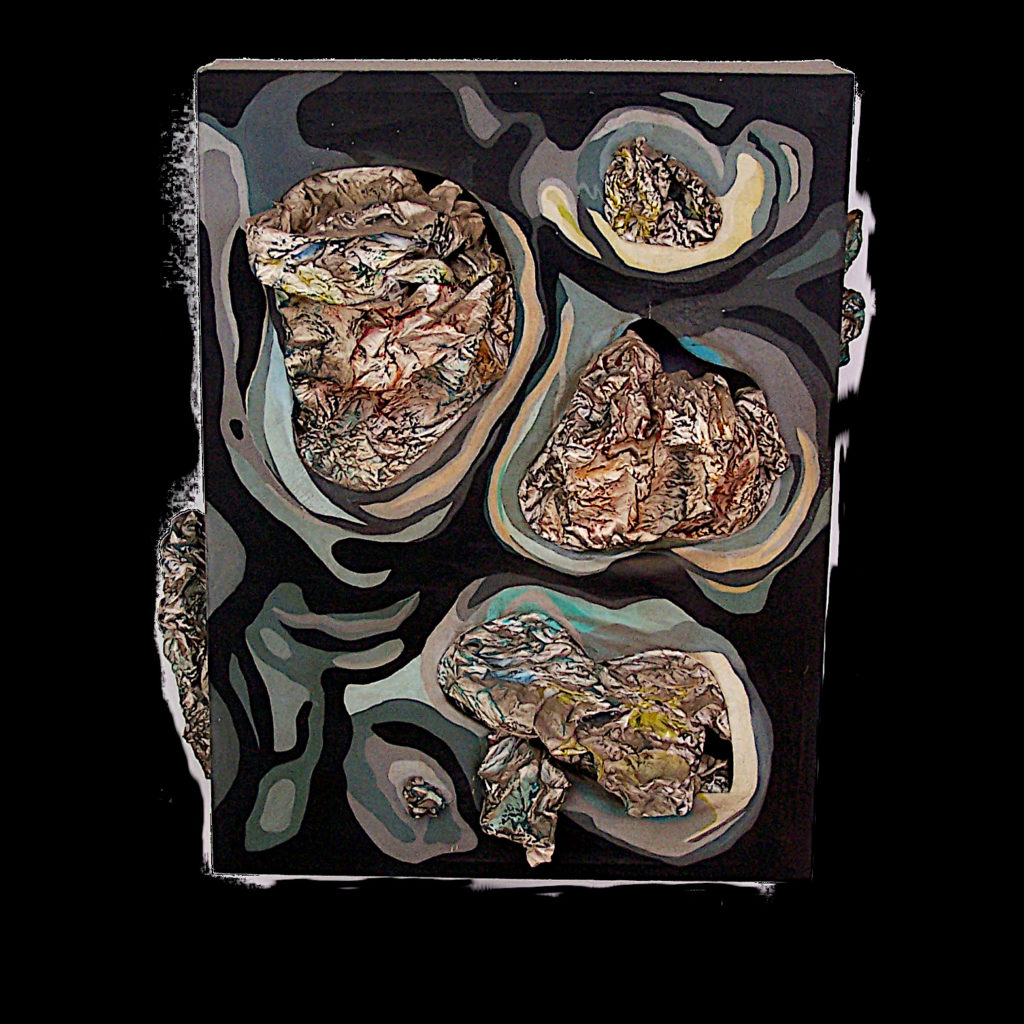
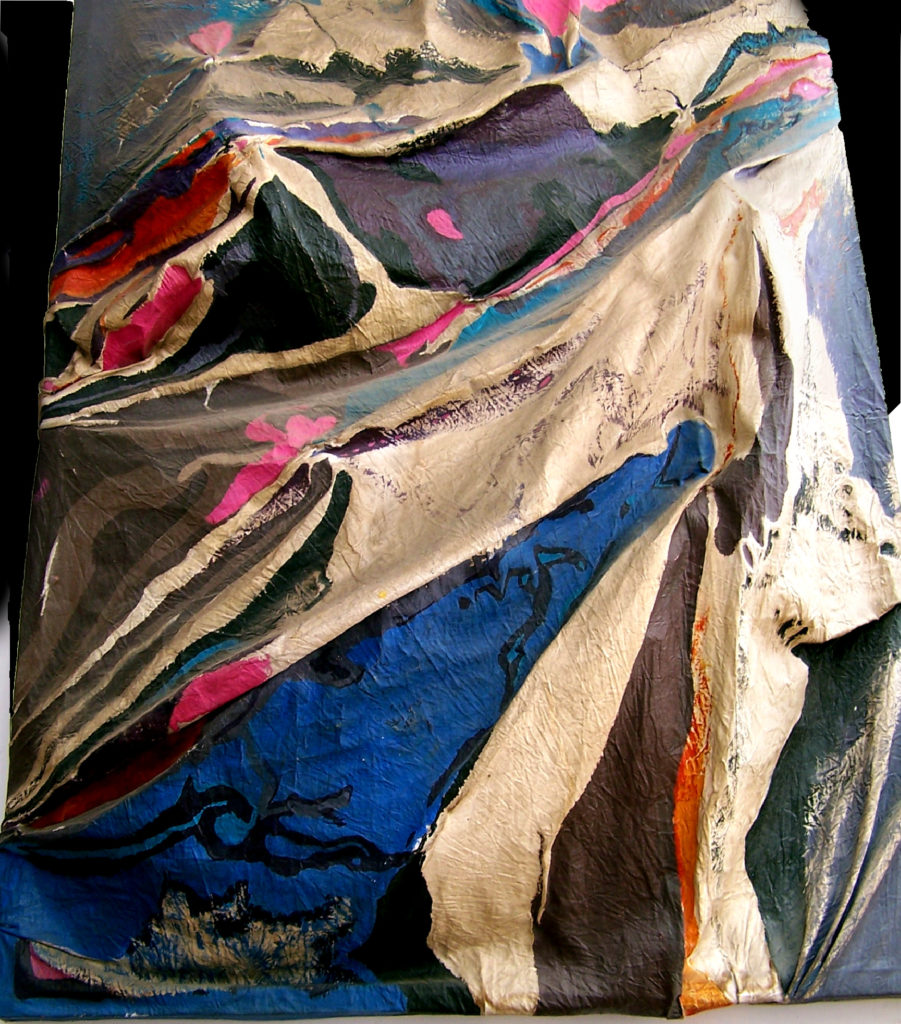
(Photos: Portrait at work by Donald Greenhaus; sculpaintings by Elsa Escamilla)

The seven peepholes to Utrana (1978)
Salón Anual de Pintura, Palacio de Bellas Artes. Mexico. Painted in the inside, concave surface of a big grapefruit form covered with a black cloth. The spectator has to discover that it is not a mere bundle but there are small red spots at different points. These are peepholes to the painting. On approaching them, a distinct fragrance is perceived at each peephole as well as electronic circuit sounds, all different. The painting can be seen in all 360 degrees around.
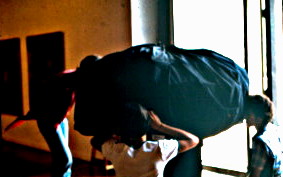

Saturday night fever (1979)
Installation with human size danceable marionettes. and participation by the public. Galería Pecanins



The 3 E’. Political piñatery (1979)
Critical participatory installation. 1. Petroleumist piñata: “managing abundance”. 2. Baby Funnel: consumerist piñata.
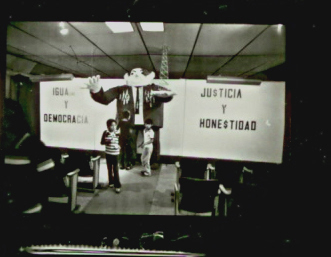
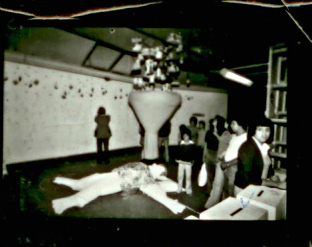
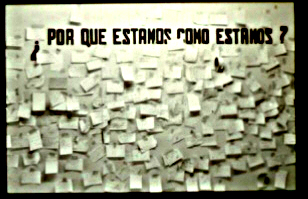
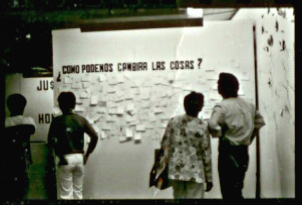
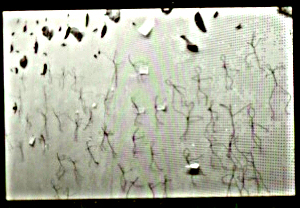
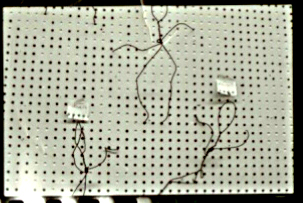
On three walls questions were placed: 1. Why are we as we are? 2. How are we getting even? 3. What can we do to change the situation? Spectators wrote their answers. The fourth wall had minuscule wire human figures climbing up the walls towards dry tortillas and chile. Unexpectedly and movingly, people wrote their names on a small piece of paper attached to a figure. This exhibition took place in Peralvillo, a very low resources neighborhood.
Tale of a child (Relato de un niño) (1982)
Audiovisual con diapositivas a 2 proyectores con disolvencias, voz (Rodrigo Osante) y música. Premio único de Audiovisual como medio de expresión creativa INBA. Consejo Mexicano de fotografía.
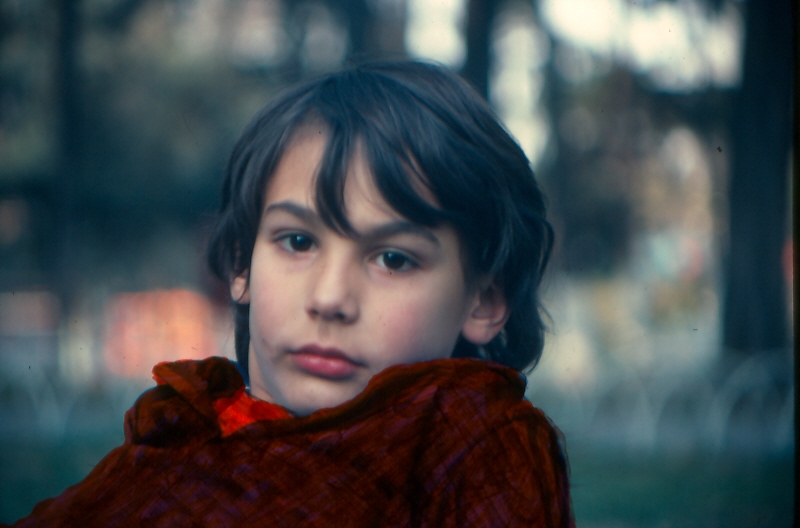

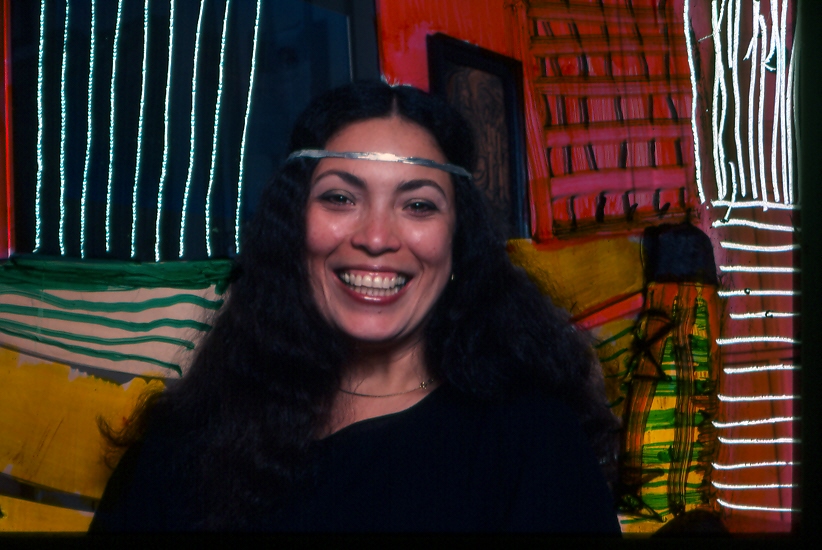
Variations on a painting by Gerszo. Sala Mauel M. Ponce, Palacio de Bellas Artes 1978.
Histogram: Distribution of Income in México (1984-5)
(Monumental climbable structure. First National Prize, in the Alternative Spaces Section 1985, INBA. Library Plaza Autonomous Metropolitan University X)
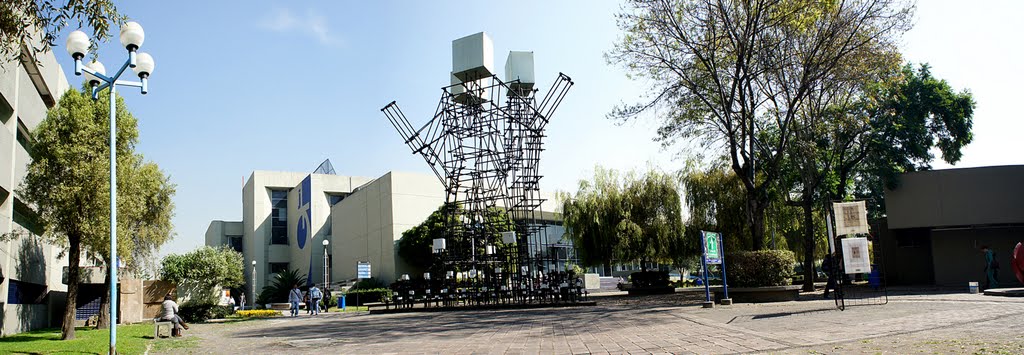

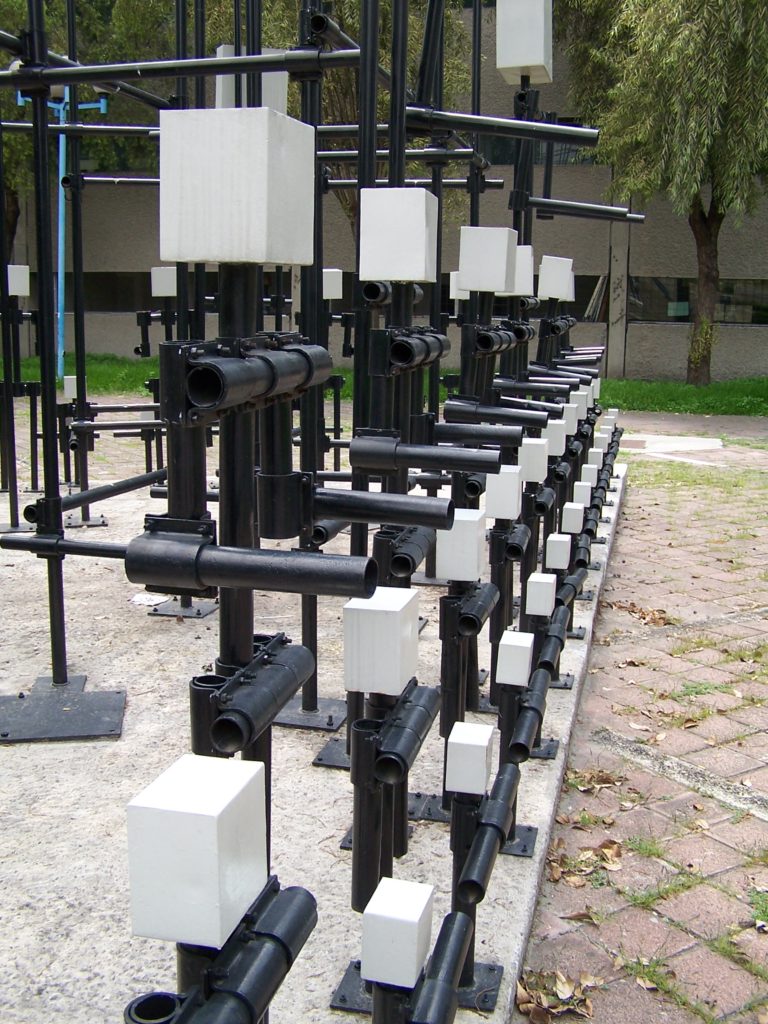
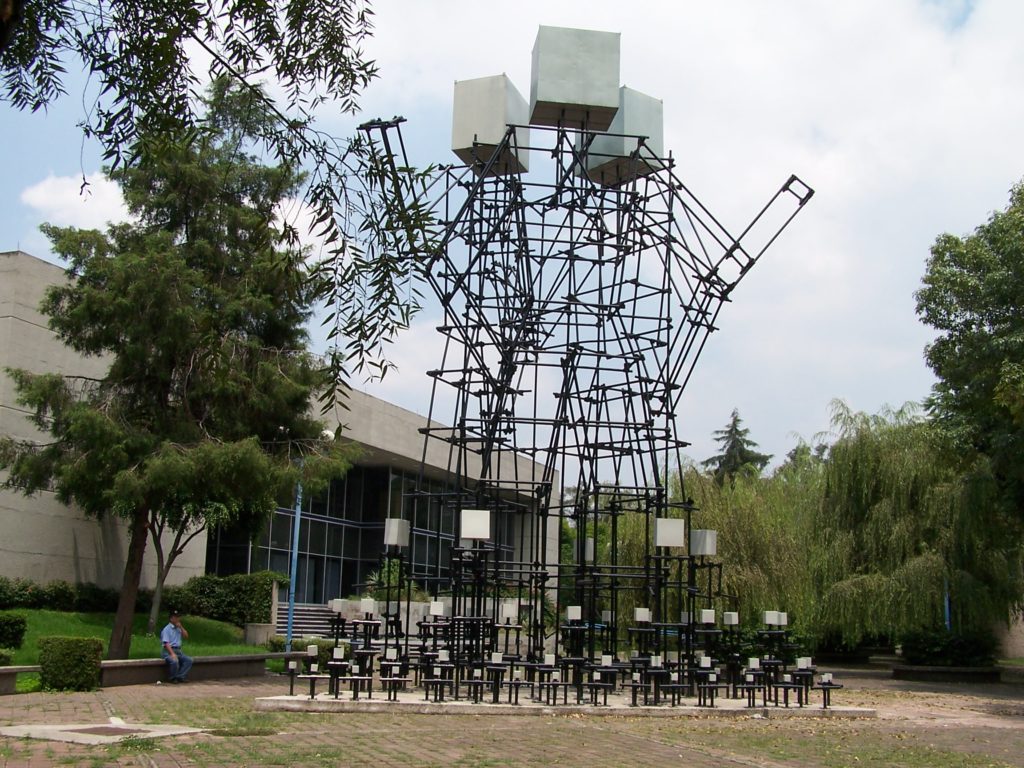
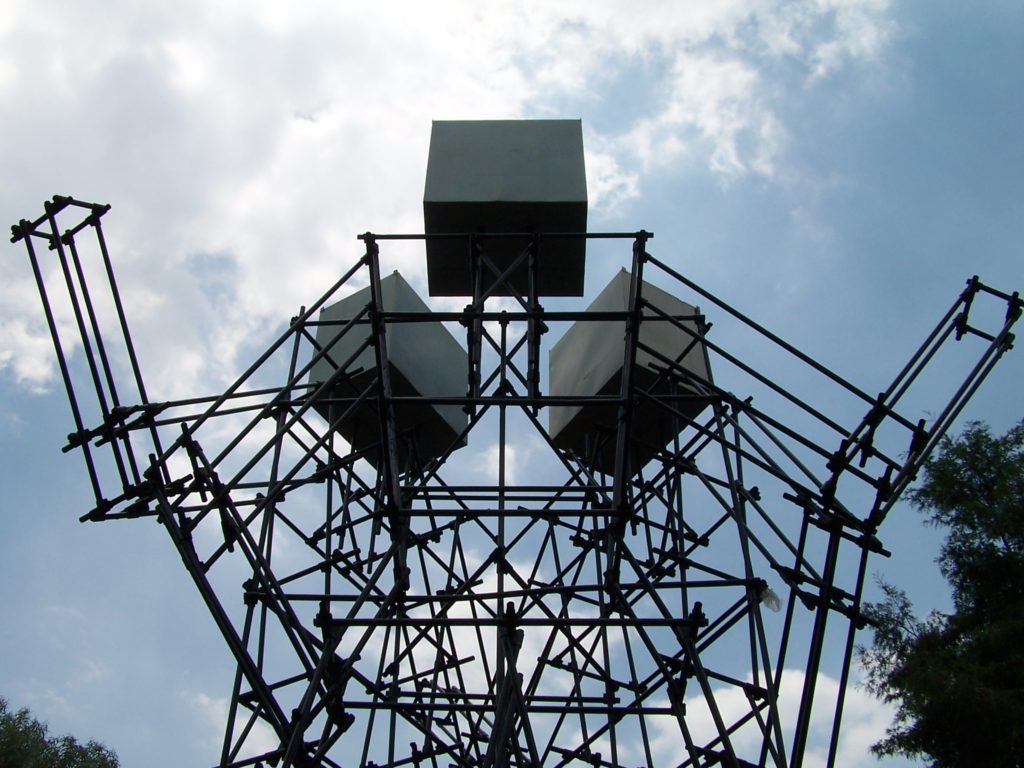
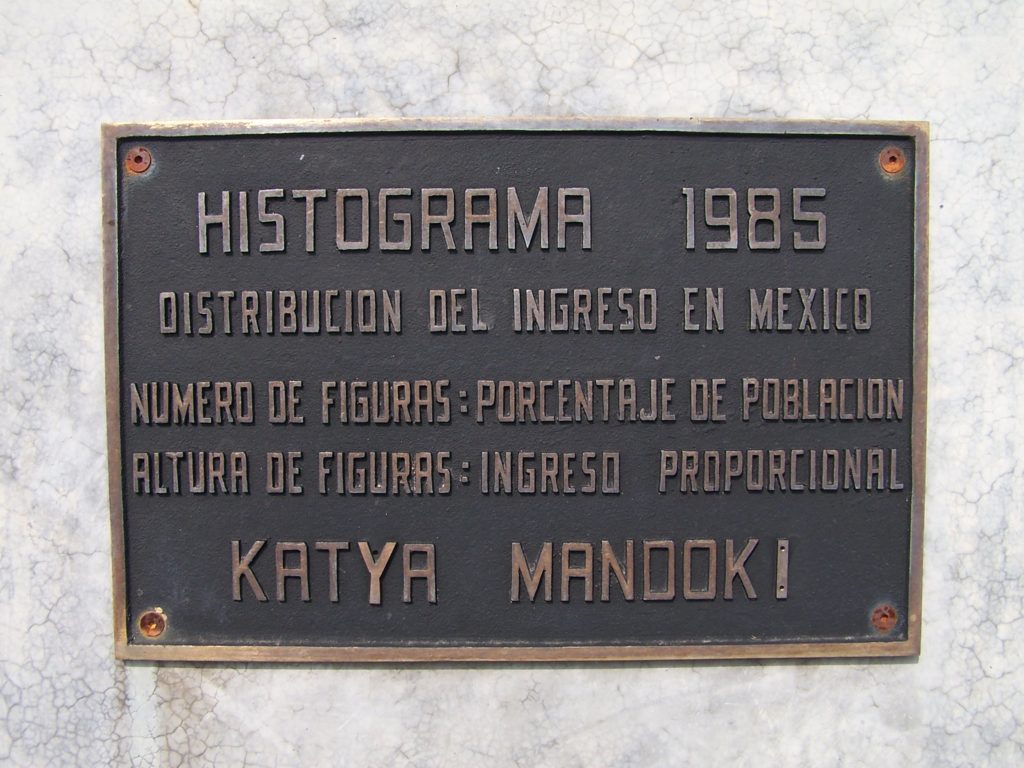
HISTOGRAM: THE DISTRIBUTION OF INCOME IN MEXICO
Katya Mandoki
(1985 Alternative Spaces Section Award, INBA; CYAD-UAM A-X research project) Presently at Library Plaza of Universidad Autónoma Metropolitana X.
Histograma is a monument to the greatest shame of this country: social inequality. It is, as its name indicates, a graph of income distribution in Mexico according to the census of the eighties. Since then, this disproportion has only gotten worse: The structure, made of scaffolding material as a metaphor for the economy, proposes the possibility of transforming it to obtain, one day, more proportionate measurements.
100 figs. height proportional to their remuneration relative to GDP = 100% economically active population.
40 fig. of .37 m. = 40% population level of misery, unemployed and underemployed
30 fig. .of 75 m. = 30% low-level population, minimum wage
21 fig. of 1.5 m. = 21% middle-level population
6 fig. of 3 m. = 6% high-level population
3 fig. of 16 m. = 3% population huge level
Review: “Within a hybrid genre, we must place, for example, the Histogram made by the Division of Sciences and Arts for Design of the Metropolitan University, under the responsibility of the versatile and intelligent Katya Mandoki: philosopher, sociologist, photographer, writer, designer, plastic artist. This sculptural installation is the product of a program made up of statistical data, socioeconomic research, minimal art in its variant of repeated structures, composition and information theories, and logical-mathematical calculation. The sum of these factors gave rise to a symbolic object of the political economic system of Mexican society and its classes. The methodical arrangement of the parts and the modules are involved in a logic that goes beyond its own form to achieve another eloquence. Geometry has become contaminated with historical significance.” Raquel Tibol “Guide to moving between alternative spaces” National Hall of Plastic Arts.
Sonatina Pasional (1982)
(Performance in variations on songs by Agustín Lara) Bar León 1982, Universidad Autónoma Metropolitana, Peña en Coyoacán.
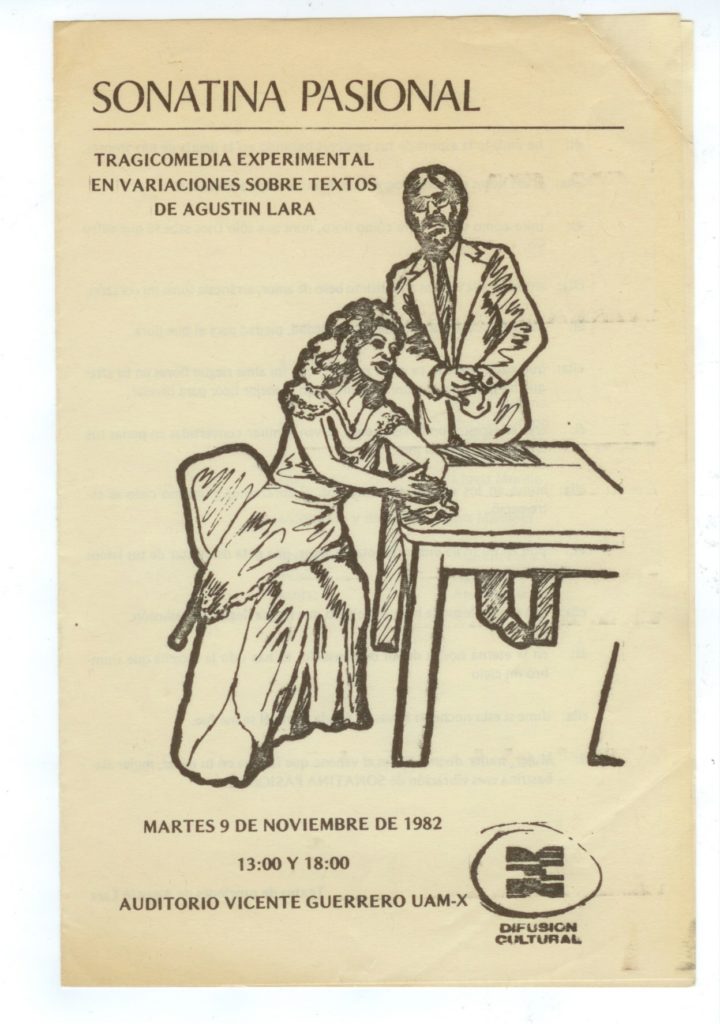
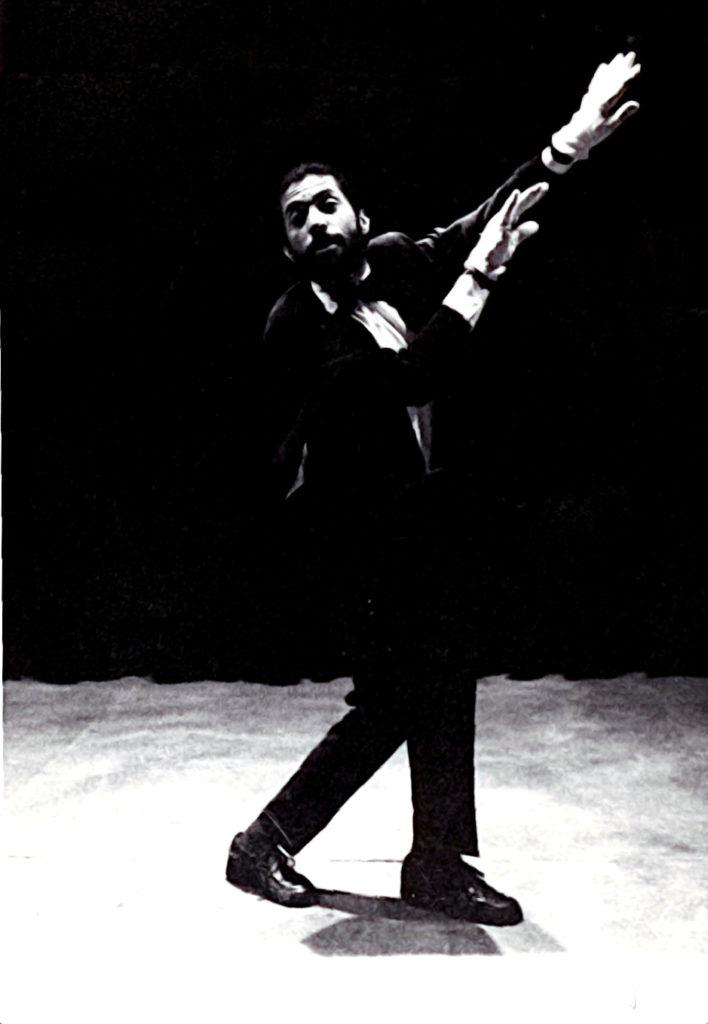
Verses of lyrics by Agustin Lara were theatricalized in different versions: tragic, comic, melancholic etc.
Acting: José Escandón, Yuriria Cañedo, Jorge Perez Grovas, Lluvia Murillo, Claudia Mandoki. Concept and direction: Katya Mandoki.
Three love stories (1981)
“Three Love Stories” Triptych in velvet and lace. 1981. Kunstlerinnen aus Mexico. Kunstlerhaus Bethanien, Berlin, D.R.A.
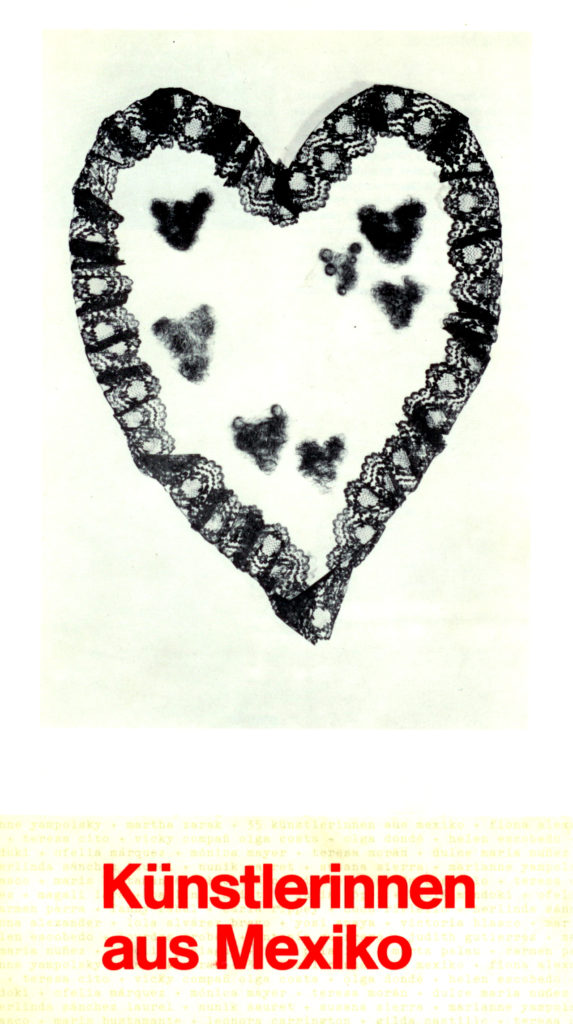
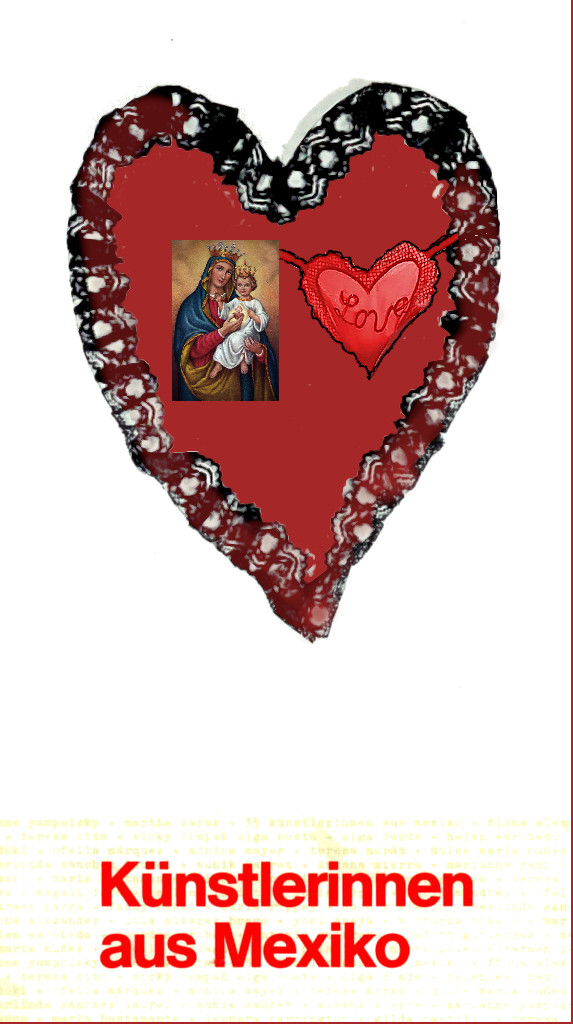
1 The seven lovers of my husband. Pubic hair on a heart-shaped white velvet base and black lace.
2 The Lupe. Stamp of the Virgin of Guadalupe with the child and erotic underpants with a red heart with lace placed on a heart-shaped red velvet base and black lace.
3 Positive. Matchbook from a cafe with a phone # written in blue ink, 2 movie tickets, a motel bill for an hour, a lab printout with a positive pregnancy test result placed on a heart-shaped black velvet base and white lace.
Sun birth 5. Parto Solar 5 (1978-1979)
Yoltéotl Group. The Aztec myth of the 5 suns is re-interpreted in the light of present political corruption in Mexico. It was presented as a video installation in three dimensional, penetrable version of the Ollin symbol of the 5 worlds according to the myth. Inside each cubicle, a monitor projected a video of each corresponding world (of monkeys, of giants, of fish etc.) in each corresponding color and situated exactly as the symbolic cardinal points in Aztec mythology. It was exhibited in the National Auditorium during the Annual Section of Experimentation (there was only one) by the Instituto Nacional de Bellas Artes and during the corresponding Latin American Biennial of São Paulo, Brazil.
Fotonovella “The Gift of the Magi” 1982
Based on the short story by O. Henry “The Gift of the Magi”. Exhibition of Mexican Photographers, Art Center, Havana, Cuba.

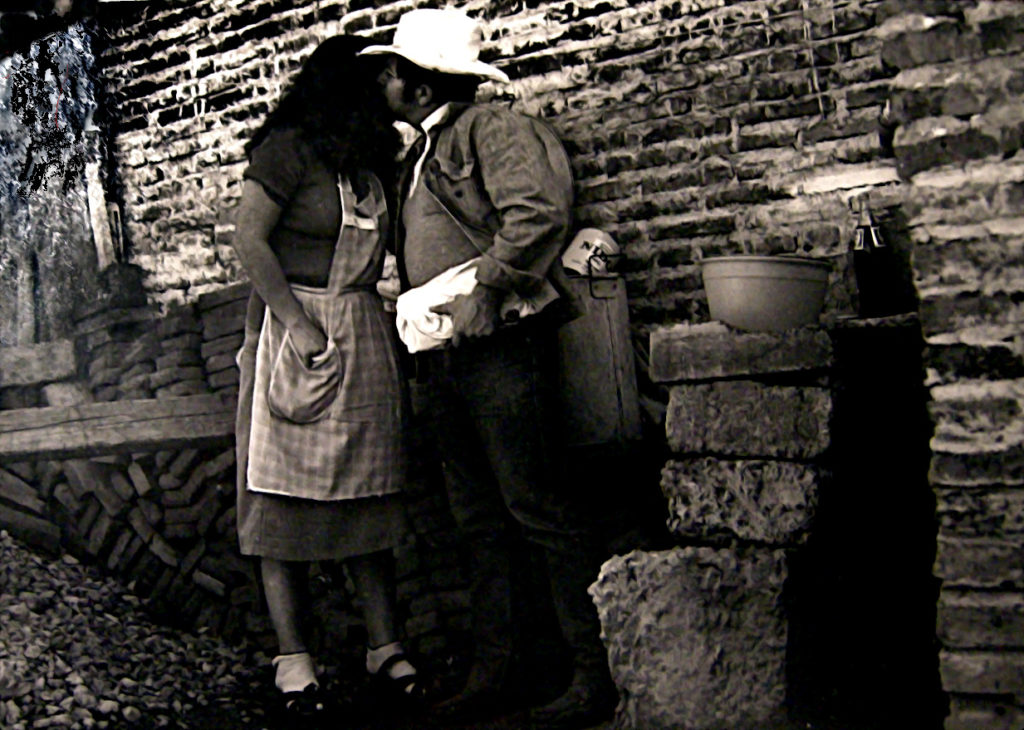
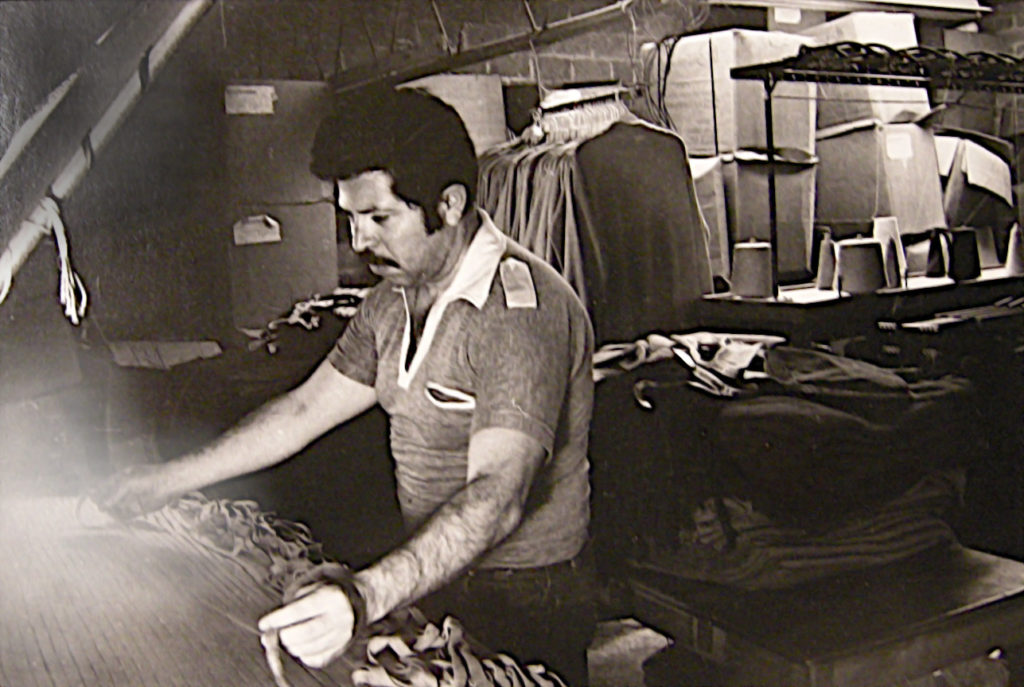
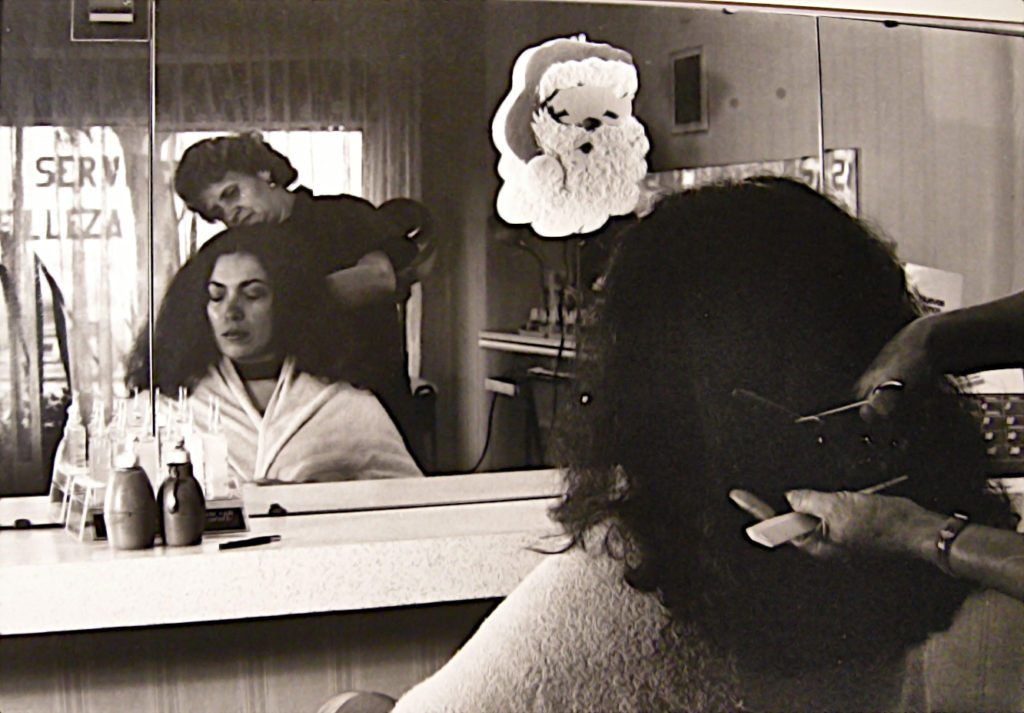
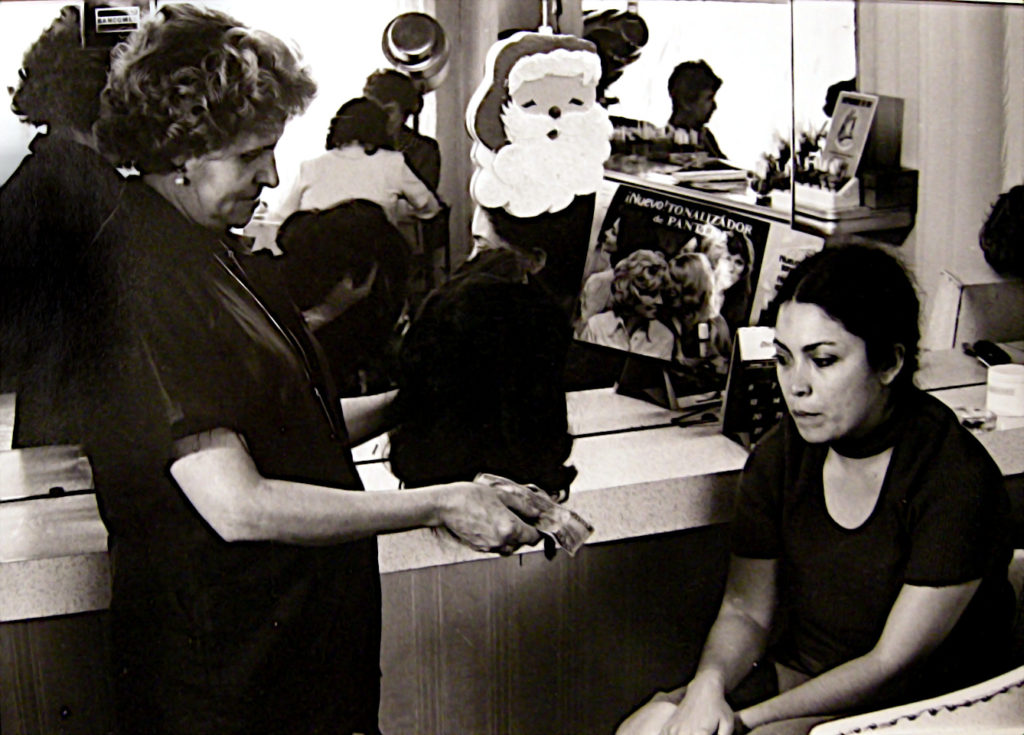


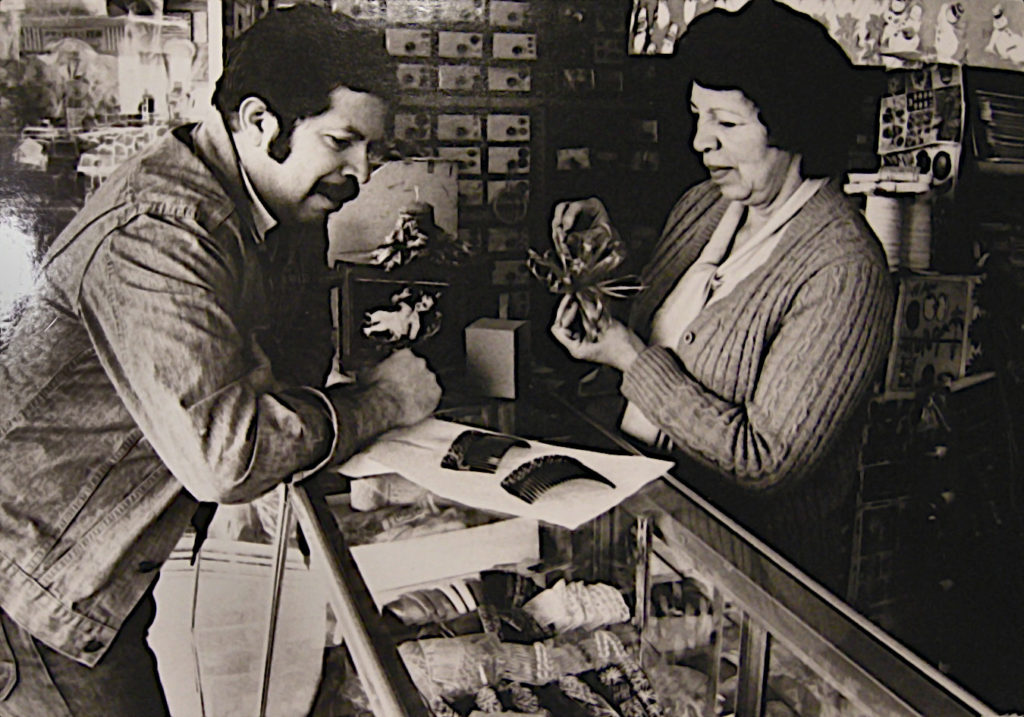
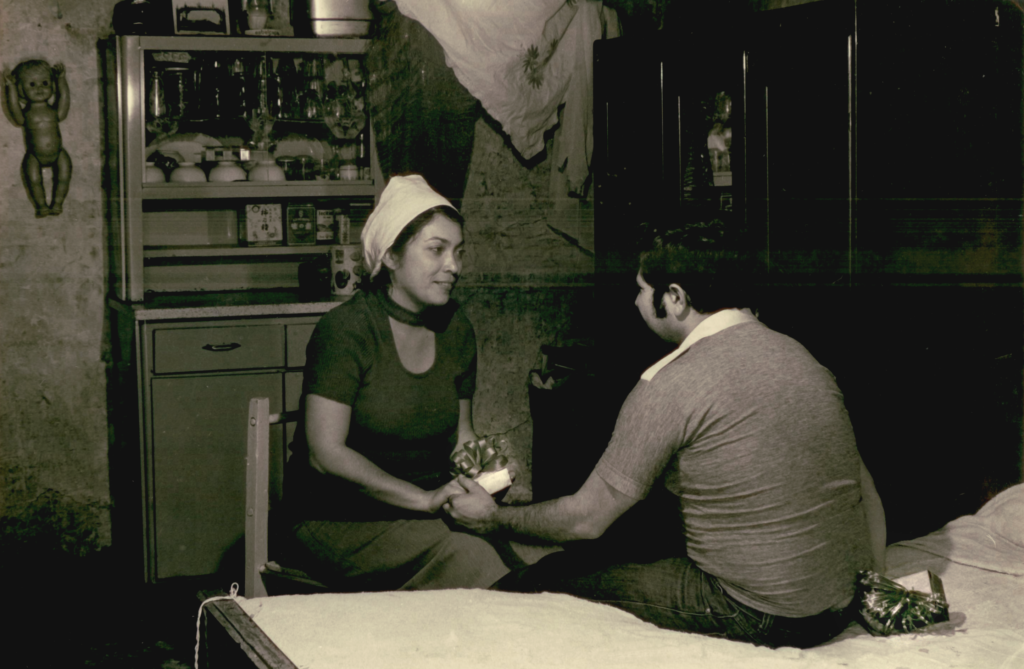
Happening “Parturition in Toronto” (1978)
Art Gallery of Ontario, Sculpture conference at Toronto.
During the opening of the International Conference on Sculpture, in the Ontario Gallery, ostentatiously pregnant, I turned pale and broke out in a sweat, squatting in the middle of the Gallery and began to push and scream. Some of the alarmed attendees shouted “Is there a doctor in the room!” while others urged me to move from there because I could stain the very fine Persian rug that supported us all. After a few pushes and grunts, I left this small sculpture from below my dress on the floor and returned to continue the conversation with my friend Manuel Felguérez. An obvious allegory of the labor, fear, and effort to give birth to an artistic statement as well.
A man enters the stage carrying a cage and starts to paint inside, hanging his paintings on the outside of the cage isolating himself until he is no longer seen. An allusion to the alienation of art from real life.
Self-censorship. Autocensura (conceptual artwork) (1979)
Palacio de Bellas Artes . A painting painted only in the head of the spectator due to constitutional prohibition to alter the flag. The painting described is a political alternation of the Mexican flag that better reflects the situation of inequality and exploitation of a capitalist devouring a worker rather than an eagle devouring a serpent. Given the legal consequences, the painting is not physically painted but actually painted in the imagination of the spectator.
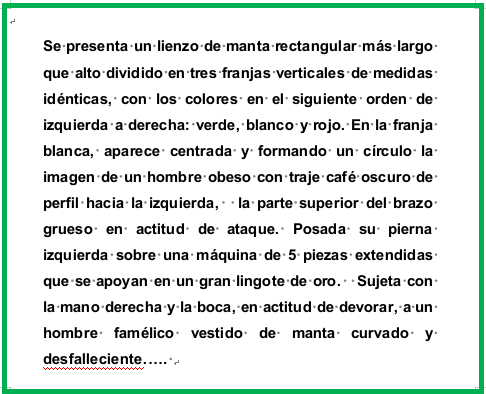
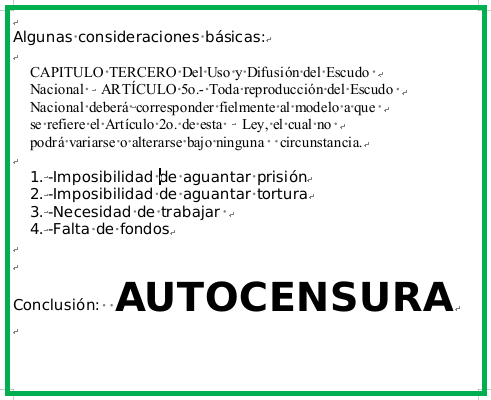
Happening “Caged Artist” (1979)
Auditorio Nacional Improvised happening of artist isolating itself from the environment within a cage of his paintings. Acting: Jorge Pérez Grovas



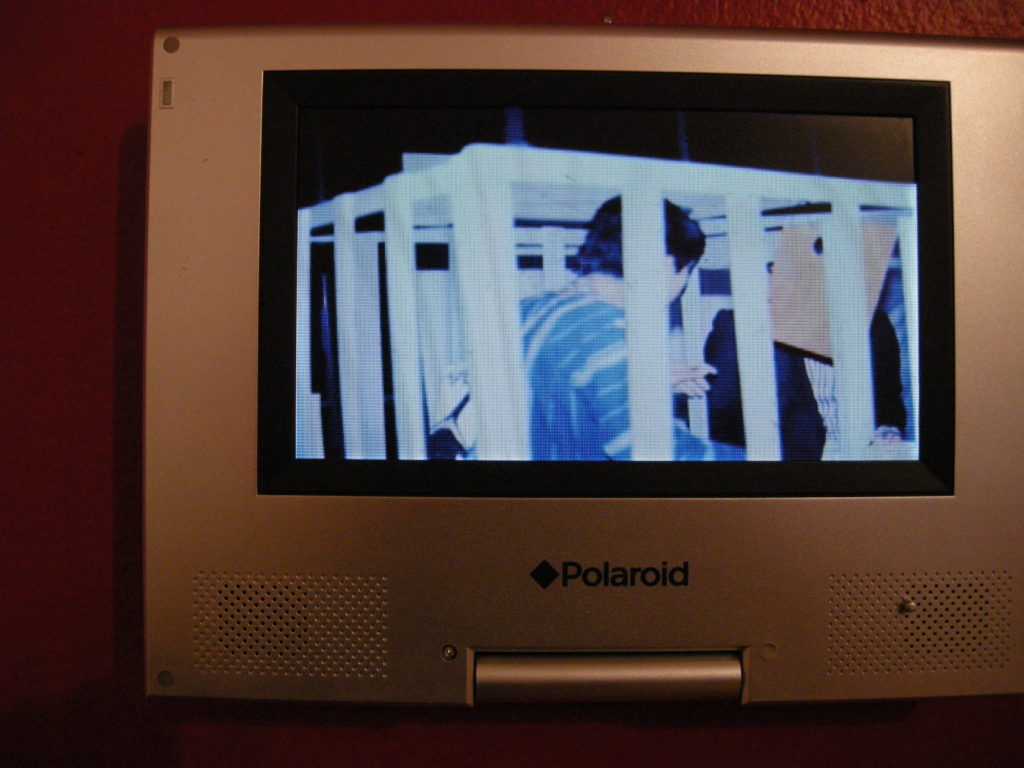
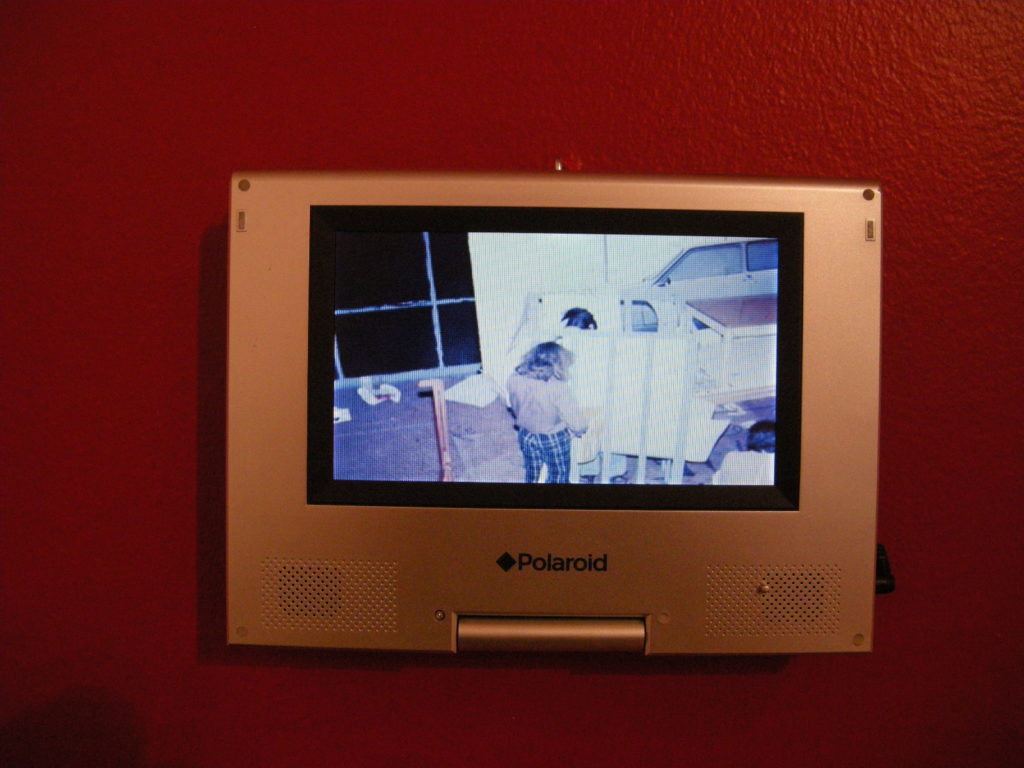
No Grupo
Fundadora con Hersua, Alfredo Núñez, Rubén Valencia, Roberto Real de León, Andrea di Castro y Susana Sierra ( después Melquiades Herrera y Maris Bustamante) del no-grupo en el estudio de Hersua. Abajo, exposición en el Museo de Arte Moderno sobre participación vía máscaras en la Bienal de jóvenes en Paris 1977 y Montaje de Momentos Plásticos, Homenaje a Gerszo, Sala Manuel M. Ponce, Palacio de Bellas Artes 1978.
